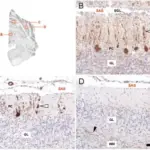Lambert-Eaton myasthenic syndrome is a rare autoimmune disorder of the neuromuscular junction.
What is the Pathology of Lambert-Eaton Myasthenic Syndrome?
Etiology: The cause of Lambert-Eaton myasthenic syndrome is often a certain type of cancer called small cell lung cancer.
Pathogenesis: The sequence of events that lead to Lambert-Eaton myasthenic syndrome involves antibodies against the voltage-gated calcium channels that mediate the release of acetylcholine which blocks the normal flow of calcium. This prevents the release of acetylcholine from its vesicles. There is little to no acetylcholine entering the synaptic cleft. Therefore, there will be minimal to no muscle contraction.
How does Lambert-Eaton Myasthenic Syndrome Present?
Patients with Lambert-Eaton myasthenic syndrome are usually males over the age of 50 years old. The symptoms, features, and clinical findings associated with Lambert-Eaton myasthenic syndrome include weakness, respiratory issues, hyporeflexia, and autonomic dysfunction.
How is Lambert-Eaton Myasthenic Syndrome Diagnosed?
Lambert-Eaton myasthenic syndrome is diagnosed via electrophysiological testing.
How is Lambert-Eaton Myasthenic Syndrome Treated?
Lambert-Eaton myasthenic syndrome has no cure. Treatments include potassium channel blockers such as guanidine and aminopyridine. Acetylcholinesterase inhibitors like pyridostigmine may help prevent the destruction of acetylcholine. Chemotherapy regimens target the associated tumor.
What is the Prognosis of Lambert-Eaton Myasthenic Syndrome?
The prognosis of Lambert-Eaton myasthenic syndrome is poor.


